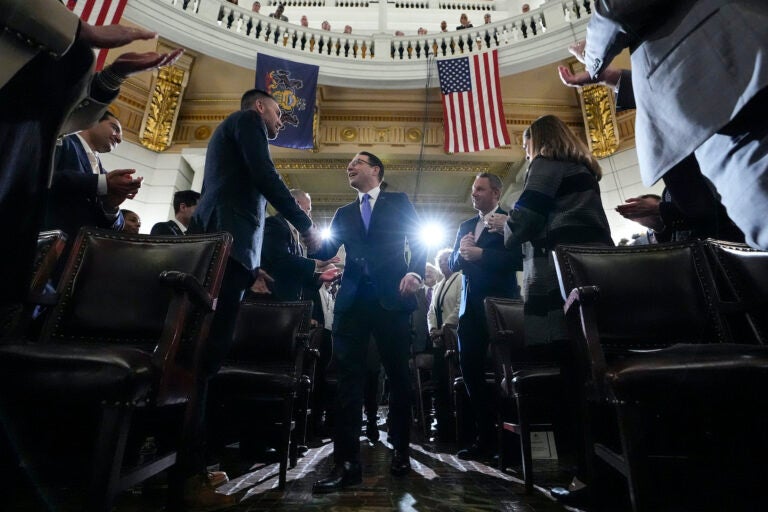In budget address, Gov. Shapiro proposes $4 million to erase medical debt for thousands of Pennsylvanians
State officials said an estimated 1 million Pennsylvanians hold some amount of medical debt, and many are subjected to debt collectors.
Listen :58
Gov. Josh Shapiro arrives to deliver his budget address for the 2024-25 fiscal year to a joint session of the Pennsylvania House and Senate in the Rotunda of the state Capitol in Harrisburg, Pa., Wednesday, Feb. 6, 2024. (AP Photo/Matt Rourke)
What you need to know
- Gov. Shapiro is proposing a “historic” $1 billion increase in education funding to address inequities
- Shapiro’s budget plan includes $161 million in funding to SEPTA amid budget shortfalls
- Calling Pa.’s minimum wage a “shanda,” Shapiro is renewing the push to raise it
- The governor is also proposing $4 million to erase medical debt for thousands of Pennsylvanians
From Philly and the Pa. suburbs to South Jersey and Delaware, what would you like WHYY News to cover? Let us know!
Unpaid medical bills account for the largest share of debt collections in the United States, and an estimated 1 million people in Pennsylvania are saddled with some amount of medical debt.
Gov. Josh Shapiro announced Tuesday during a state budget address in Harrisburg that he wants to use $4 million in state dollars to buy and wipe out some of that debt for thousands of people across the commonwealth.
“This debt is an anchor holding those families and communities back. When you can’t afford to pay it off, your credit score suffers and it makes it harder to reach financial stability,” Shapiro said. “With an investment of just $4 million in my budget, we can start wiping out medical debt for Pennsylvanians and give them the chance to succeed financially.”
Collectively, Pennsylvania residents share more than $1.8 billion in medical debt in a collections stage as of December 2020, according to state officials.
The issue disproportionately affects Pennsylvania’s rural communities — Warren, Greene, Bradford, Franklin and McKean counties have the state’s highest share of residents with medical debt.
“In Warren County alone, 20% of residents carry medical debt that’s affecting their credit,” Shapiro said.
The proposed $4 million in state funds would likely pay off millions more in unpaid medical bills since medical debt is often sold “for pennies on the dollar,” said Dr. Luke Messac, an emergency physician and historian based in Boston.
Messac’s book, “Your Money or Your Life: Debt Collection in American Medicine,” was released in November and covers the history and practice of medical debt collection.
Medical debt usually starts when a hospital or medical provider sends a bill to the patient. Some health systems and organizations offer financial assistance programs and sliding scale payment options, but Messac said many people are still left facing charges they cannot afford to pay.
For example, when a bill for $10,000 goes unpaid, hospitals or health offices will sell the patient’s debt to third-party collection companies at a fraction of the amount — maybe several hundred or a couple thousand dollars.
Debt collectors will then pursue payment from the patient at face value, or the $10,000 amount listed on the original hospital bill. This is how collection companies make a profit, Messac said.
“They know that they won’t get the face value of the debt in the vast majority of cases, but they’ll seek to aggressively collect it as much as they can,” he said.
Messac said collectors might report that debt to the credit bureau, then negotiate a payoff amount or payment plan with patients trying to repair their damaged credit.
“Or you might take the patient to court,” he said. “The patient will get a notice that they’re being taken to court, their wages are being garnished — 25% of their take-home pay is being taken out of their paycheck and sent directly to the debt collector — or something even worse.”
Pennsylvania health advocates praised Shapiro’s proposal. Antoinette Kraus, executive director of the Pennsylvania Health Access Network, said the $4 million amount could potentially wipe out as much as $400 million in medical debt for families across the state.
“Millions of families struggling with medical debt are making sacrifices like choosing between paying medical bills and paying for food, clothes, utilities, or other necessities and using up all or most of their savings,” Kraus said in a statement.
Kraus said debt relief could be a “game-changer ” if combined with proposed state legislation to create a medical debt relief program for residents with low incomes.

Get daily updates from WHYY News!
WHYY is your source for fact-based, in-depth journalism and information. As a nonprofit organization, we rely on financial support from readers like you. Please give today.





